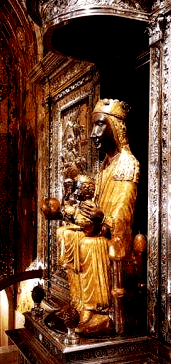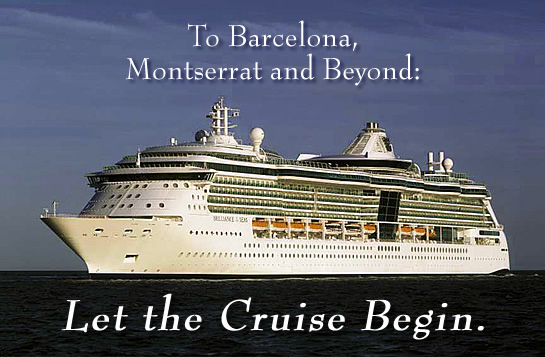 |
The Brilliance of the Seas
“It [Montserrat] stands single, towering over an hilly country,
like a pile of grotto work or Gothic spires.”
— Henry Swinburne (1779)
By Ron Fritze
DATELINE: Barcelona, Spain
May 11, 2009
On 9 May, Twylia and I drove up to Nashville to catch a plane bound for Barcelona. Our cruise ship sails from the Spanish port today. We will return there on 22 May and hopefully back to Nashville on the same long day. Our fourth cruise will mark our return to the Royal Caribbean Line ship, The Brilliance of the Seas. It used to be one of their biggest ships, but now the class that includes The Independence of the Seas is bigger. We have some old friends on The Brilliance, and we hope to see them again.
Barcelona is one of the busier cruise ports. Many cruises start there and make a circuit of some part of the Mediterranean. Other cruises start at Barcelona and finish at some other port, commonly Venice, or they start at some other port and finish at Barcelona. Many travelers visiting the region for the first time are surprised to find that most of the basin of the Mediterranean Sea has a rather dry climate, similar to southern California but for somewhat different climatic reasons. There are lots of sunny days. In the summer it can be brutally hot at times, but most people enjoy Barcelona. Twylia and I have not had enough time there to really appreciate its evident charms.
Climbing the Jagged Peaks
to the Sanctuary of the Black Virgin
One place we did see during our last visit here was the mountain and monastery of Montserrat, which lies about 30 miles outside of Barcelona. It is said that the Romans named the mountain Montserrat because of its jagged peaks, which are reminiscent of a serrated knife’s blade. The mountain, set by itself, is definitely distinctive. When you see its jagged peaks in the distance, you know in an instant that it is Montserrat.
The peak rises to about 4,000 feet. Near its top is a Benedictine monastery. Although the monastic community on Montserrat is very old, its buildings are only a few hundred years old, the originals having decayed from age or fallen to the ravages of war.
The origins of the monastic community are obscure, although their
purpose is clear: the monks and priests are caretakers of the Black Virgin, familiarly known as “La Morenita or Moreneta.” The statue of the virgin is about a meter in height.
 St. Mary has long been the patron saint of Catalonia due to the popularity of “La Moreneta.” According to one legend, the Evangelist St. Luke made the statue in 50 A.D. It was brought to Spain by St. Peter, who gave it to St. Eterius, the first bishop of Barcelona. There the statue stayed until 717 when Muslims from North Africa invaded Spain and were approaching Barcelona. In the confusion, the sacred statue was hidden in a cave on Montserrat where it remained for over a century.
St. Mary has long been the patron saint of Catalonia due to the popularity of “La Moreneta.” According to one legend, the Evangelist St. Luke made the statue in 50 A.D. It was brought to Spain by St. Peter, who gave it to St. Eterius, the first bishop of Barcelona. There the statue stayed until 717 when Muslims from North Africa invaded Spain and were approaching Barcelona. In the confusion, the sacred statue was hidden in a cave on Montserrat where it remained for over a century.
Popular among Pilgrims
There are lots of legends concerning the finding of the statue and the founding of the monastic community, but solid historical evidence is scarce. It appears more likely that the Black Virgin and the monastic community came into being around the twelfth century and quickly became a popular destination for pilgrims. Montserrat has remained a popular place for pilgrims to visit ever since. Its visitors have included Ferdinand and Isabella and Ignatius Loyola.
For those travelers seeking both an active and a contemplative vacation, Montserrat would be quite good to add to the itinerary. Santiago de Compostela would be even better, but it requires a greater commitment of time from the wayfarer. Someday Twylia and I would like to do both on foot, but that is a something left for a healthy retirement. We did visit Montserrat on an excursion at the end of the cruise two summers ago, but this time ‘round we will have to call upon memory as time is short and new opportunities plentiful.
From Barcelona this evening The Brilliance of the Seas will steam toward Palermo, the medieval capital of Sicily. My hope is to visit the grave of the great Holy Roman Emperor Frederick II, known as the Stupor Mundi, the wonder of the world.
In Search of the Anti-Cythera Machine
The next stop is Athens. Twylia and I visited there once before, but this time I’m setting my sights on the ancient computing device known as the Anti-Cythera machine. After Athens, the great ship will stop at Rhodes (Colossus is long gone), Cyprus, Alexandria (my first time in Egypt), and Malta (site of one of the greatest sieges in the history of warfare). Then we're back at Barcelona.
Returning to one of my favorite regions of the world, I definitely agree with Samuel Johnson that the Mediterranean is a grand object of travel, especially if you are interested in history.
“The grand object of travelling
is to see the shores of the Mediterranean.”
— Samuel Johnson (1776)

Cannes,
Florence,
Rome,
and Sardinia |

Of Mountains,
Monkeys,
and Men
|

Rambling
'tween
the Itchen and
the Scratchen |
Click on the black panther to read about Ron Fritze's new book,
"Invented Knowledge: False History, Fake Science, and Pseudo-religions." |
 |














 |
 |




 St. Mary has long been the patron saint of Catalonia due to the popularity of “La Moreneta.” According to one legend, the Evangelist St. Luke made the statue in 50 A.D. It was brought to Spain by St. Peter, who gave it to St. Eterius, the first bishop of Barcelona. There the statue stayed until 717 when Muslims from North Africa invaded Spain and were approaching Barcelona. In the confusion, the sacred statue was hidden in a cave on Montserrat where it remained for over a century.
St. Mary has long been the patron saint of Catalonia due to the popularity of “La Moreneta.” According to one legend, the Evangelist St. Luke made the statue in 50 A.D. It was brought to Spain by St. Peter, who gave it to St. Eterius, the first bishop of Barcelona. There the statue stayed until 717 when Muslims from North Africa invaded Spain and were approaching Barcelona. In the confusion, the sacred statue was hidden in a cave on Montserrat where it remained for over a century.


